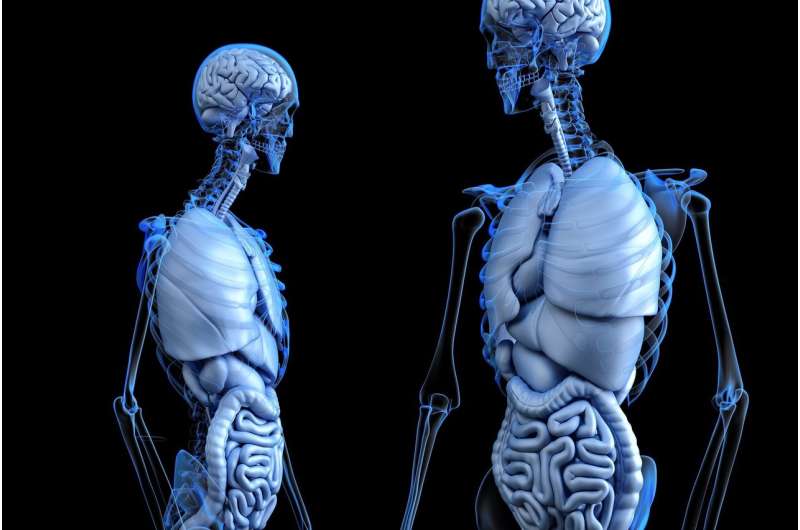Credit: CC0 Public Domain
A new study reported in STEM CELLS reveals a unique population of skeletal stem cells (SSCs) that function during the transitional period between rapid bone growth and bone maintenance. This discovery provides an opportunity to determine whether alterations in the SSCs' pattern might affect bone formation, as well as helps us understand the physiological factors that regulate its timing.
"This is particularly important given that anything that interferes with the proper development of bone mass during childhood and adolescence has long-lasting effects on our health, including the development of osteoporosis in adults," said corresponding author Diana L. Carlone, Ph.D., of Boston Children's Hospital and the Harvard Stem Cell Institute.
The researchers came across this new information while investigating the role of mTert-expressing cells in postnatal mouse long bone. Postnatal bone formation relies on skeletal progenitor/stem cells. These cells also play a key role in repairing fractured or otherwise damaged bone. Tert (telomerase) is an enzyme found in the body's cells that helps keep cells alive by adding DNA to the ends of their chromosomes (telomeres). Each time a cell divides, its telomeres lose a small amount of DNA and become shorter. Tert activity prevents this aging process.
Recent lineage-tracing data indicate that SSC populations are regulated by time and spacing, with distinct populations functioning during bone growth and maintenance. In addition, growth-associated SSCs have been suggested as the predecessors to adult SSCs, implying that the SSC populations are highly complex and perhaps exist in hierarchies. There is strong interest in identifying stem cells within the skeleton, and much has been done to understand these cells in vitro (in the test tube); however, these findings are tempered by the fact that the lineage potential of cells in vitro can differ from their capacity in vivo (in the body).
"Going forward it will be imperative that markers and the cell populations they identify are validated in vivo before being accepted as an SSC population," Dr. Carlone said.
Previously, she and her team had shown that mTert expression marks embryonic stem cells, induced pluripotent stem cells and self-renewing tissue stem cells. Other researchers had proven that telomerase is necessary for SSC self-renewal and differentiation, and that a decline in telomerase activity in humans correlates with a decrease in bone homeostasis (stability), leading to osteoporosis. While all these studies indicate that telomerase is important for SSC function and bone homeostasis, what remained unclear was whether telomerase expression marks skeletal stem cells.
That's what the Carlone team set out to discover. They already knew that discrete SSC populations function during specific time periods corresponding to rapid bone growth and bone maintenance. To investigate whether mTert is expressed during these same periods, the Carlone team examined the long bones of an mTert mouse model they had developed, which recapitulates endogenous telomerase activity, specifically looking at what was happening at one, three and 12 weeks of age. To do this, they used quantitative (q) RT-PCR analysis (reverse transcription-polymerase chain reaction), which is the most sensitive technique for mRNA detection and quantitation currently available.
What they learned is that although mTert was detected at low levels during the multiple time points, it was upregulated at the age of weaning (three weeks), suggesting that mTert+ cells are temporally regulated and mark a discrete time period interposed between rapid bone growth and bone maintenance. They next looked at the location of the mTert-expressing cells at these same endpoints and were able to identify the mTert+ cells in regions known to house SSCs, including the fibrous tissue at the ends of long bones (the metaphyseal stroma), as well as in the growth plate and the bone marrow.
"We also show that mTert-expressing cells are a distinct SSC population with enriched colony-forming capacity and contribute to multiple mesenchymal lineages in vitro. In contrast, in vivo lineage-tracing studies identified mTert+ cells as osteochondral progenitors and contribute to the bone-forming cell pool during endochondral bone growth, with a subset persisting into adulthood," Dr. Carlone noted.
"Taken together, our results show that mTert expression is temporally regulated and marks SSCs during a discrete phase of transitional growth between rapid bone growth and maintenance that corresponds to the adolescent growth spurt in humans. We believe this warrants future studies focused on understanding how alterations in this cell population during this growth period translate into disorders such as osteoporosis."
"The temporal regulation of telomerase in the progenitor cells that form bone during adolescent growth is a very important advance in the understanding of bone development," said Dr. Jan Nolta, Editor-in-Chief of STEM CELLS. "This knowledge could also aid in understanding and improving regenerative therapies for bone injury and disease."
More information:
Diana L. Carlone et al. Telomerase expression marks transitional growth‐associated skeletal progenitor/stem cells. STEM CELLS.
First published: 13 January 2021 doi.org/10.1002/stem.3318
Journal information: Stem Cells
Provided by AlphaMed Press
























